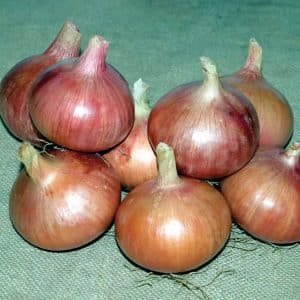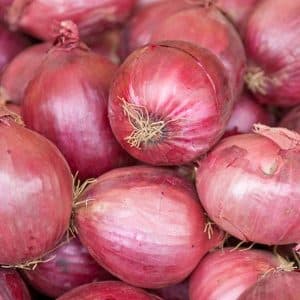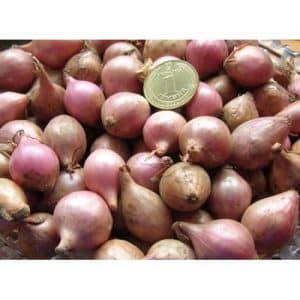The most delicious Rossana onion variety: description and growing tips
Beautiful bulbs with a pleasant sweetish taste are the hallmark of the Rossana variety. It is not difficult to purchase the seeds of this onion, but in order to get a high-quality harvest and be convinced of the positive qualities of the variety, you need to know some of the nuances of planting and caring for it.
Description of the Rossana variety
The bulbs of this variety have a pleasant sweet-spicy taste and are suitable for fresh consumption. Due to the preservation of beneficial properties after heat treatment, Rossana is often used as an additive to dishes that require boiling, frying or stewing. Onions are also suitable for drying, salting and pickling.
Rossana onions were bred by Italian breeders, the originator of the variety is ISI SEMENTI S.P.A.
Included in the state register of Russia in 2003.
Chemical composition, trace elements and vitamins and beneficial properties
Rossan's onion contains:
- potassium;

- sodium;
- manganese;
- magnesium;
- phosphorus;
- iron;
- vitamins E, C, PP, group B;
- proteins;
- carbohydrates;
- fiber;
- organic acids.
The rich vitamin composition makes onions an excellent remedy in the fight against vitamin deficiency. The vegetable also helps remove cholesterol from the body, minimizing the risk of diseases heart and blood vessels and effectively fights viruses and bacteria.
Ripening period and yield, disease resistance
This is a mid-season variety - the harvest can be harvested 112-125 days after the appearance of full shoots.
Marketable yield is 186-282 c/ha.
Reference. The maximum yield was recorded in the Krasnodar Territory - 674 c/ha.
If the rules of care are followed, the variety is resistant to infectious and fungal diseases.
Characteristics of the bulb, description of appearance, taste
The Rossana variety produces oval-rounded bulbs that weigh on average 50-70 g, but some specimens reach a weight of 150 g.
Dry scales are dark red, the flesh is pink, juicy, the taste is semi-sharp.
Which regions are best suited and climate requirements?
The variety is included in the state register for the North Caucasus region, and it is successfully grown in all regions of Russia.
Reference. In northern regions, it is important to control soil moisture levels.
The main advantages and disadvantages of the Rossana variety
Advantages of Rossana:

- good keeping quality and ripening;
- disease resistance;
- high productivity;
- unpretentiousness to soil composition.
The disadvantages of the variety include its heat-loving nature - this onion does not tolerate low temperatures, which can lead to the death of the crop.
What is the difference from other varieties
A comparison of Rossana with other mid-season onion varieties is presented in the table:
| Variety | Bulb shape | Bulb weight, g | Taste | Productivity, c/ha |
| Rossana | Oval-round | 50-70 | Peninsular | 186-282 |
| Alba | Round | 70-80 | Peninsular | 300-320 |
| Alvina | Flat | 60-80 | Peninsular | 144-260 |
| Banquo | Round | 52-82 | Peninsular | 90-212 |
| Bashar | Round | 95-120 | Peninsular | 277-401 |
| White Eagle | Rhombic | 70-100 | Peninsular | 120-218 |
Features of planting and growing
The seeds of this onion can be sown directly in open ground, but the seedling method will significantly increase the yield. It is important to provide the onion with proper conditions, otherwise it will lose its positive qualities.
Preparing for landing
To speed up seed germination and strengthen the immunity of future plants, preliminary preparation of planting material is carried out.
About a week before sowing, the seeds are placed in a solution of potassium permanganate (0.1 g per 1 liter of water) and left in it for a day at a temperature of +20..+25°C. After this, the swollen seeds are laid out between two layers of damp cloth. After 2-3 days, sprouts will appear, after which the seeds are slightly dried and sown in previously prepared containers.
The area for planting future seedlings is prepared in advance: weeds and plant debris are removed, the soil is loosened and applied to each square meter. m. 5 kg of peat, 4 kg of humus, 1 tbsp. l. superphosphate and 1 tsp. urea.
The Rossana variety is not picky about soil composition and grows well in any soil.
Dates, scheme and rules of planting
Seeds for seedlings are sown at the end of February or beginning of March, following the following scheme:
- Warm the soil mixture to room temperature in advance and pour it into prepared containers.
- Make holes in the soil at a distance of 3-4 cm from each other.
- Place 2-3 seeds in each hole, deepening them by a maximum of 2 cm.
- Sprinkle the crops with soil, lightly compact it and water.
- Cover the containers with polyethylene and put them in a room where the air temperature is at least +20°C.
The improvised greenhouse is checked and ventilated daily, and after the first shoots appear, the polyethylene is removed.
Seedlings are transplanted into open ground in the spring, when the average daily temperature is at least +10°C and the soil is still moist.
Reference. At the time of transplantation, the seedlings should be 35-40 days old, they should grow to 10 cm, have a developed root system and several leaves.
Transplant process:
- Two days before planting, warm up the seedlings by placing them in a room with a higher air temperature.
- Prepare beds on the site with a row spacing of 20 cm.
- Make indentations in them every 10 cm.
- Place the seedlings in them, deepening them by 3-5 cm.
Features of cultivation
For the seeds to germinate, it is enough that the air temperature is +4...+5°C; a comfortable temperature for further growth and development of onions is +12...+14°C.
The Rossana variety loves light, so the area should be well lit.
It is better to plant onions on a hill. This variety tolerates drought well, but is sensitive to high humidity, so in lowlands where water accumulates there is a high risk of plant rotting.
Onions cannot be planted two years in a row in the same place, and the best predecessors of the variety are zucchini, cucumbers, cabbage, tomatoes, and potatoes.
Nuances of care
To obtain a high-quality harvest, plants are provided with proper care.
Onions are watered every 10 days, using drip irrigation or pouring water into the rows. When using the sprinkling method, water is retained between the leaves, which leads to rotting of the heads, and watering under the bulbs prematurely exposes them from the ground.
Watering is stopped 14-20 days before harvesting.
The soil around the onions is carefully loosened after each watering or rain to prevent the formation of a crust on the surface of the soil and improve its aeration.
Also, the soil is regularly weeded, removing weeds from it, which takes nutrients from the soil, prevents air from reaching the underground part of the plants and shades the plantings, causing increased humidity.
Fertilizers stimulate plant growth. The plants are fed twice with different compositions:
- dilute 1 tbsp in 10 liters of water. bird droppings and 1 tbsp. l.urea, the resulting solution is used to water the beds, consumption - 3 liters of fertilizer per 1 sq. m;
- after 14 days, re-feeding is carried out - 2 tbsp. l. nitrophoska is diluted in 10 liters of water and watered plants at the rate of 5 liters per 1 sq. m.
Disease and pest control
If agrotechnical requirements are violated, Rossana may be affected by:
- powdery mildew or downy mildew – potassium-phosphorus fertilizers are added to the soil, which help strengthen the immunity of onions and the plants are treated with fungicides;
- gray mold – treat with fungicidal preparations or a solution of wood ash (1 tbsp. wood ash and chalk and 11 tsp. copper sulfate per 10 liters of water, consumption - a bucket per 3 sq. m.);
- jaundice – the disease cannot be treated, infected plants are removed.
From pests Onion flies and root mites are dangerous for the variety. To get rid of them, plants are treated with insecticides and acaricides or carrots are planted nearby, which repel the onion fly.
Harvest and storage
Term harvest storage depends on how correctly and timely it was collected.
How and when to collect
Ripe bulbs are harvested at the end of July or beginning of August, in dry and sunny weather, by pulling them out of the ground.
Reference. They begin collecting as soon as the feathers on a quarter of the bed begin to bend to the ground and dry.
Storage features and keeping quality of the variety
The collected bulbs are inspected and sorted: damaged specimens are thrown away or set aside for immediate use. Whole, high-quality heads are dried well, the tops and long roots are cut off, cleaned of dirt and placed in cardboard boxes or wooden boxes.
Store onions in a dry, dark and well-ventilated area at a temperature of +15...+20°C.
Keeping quality of the variety – 65-75%, yield without loss of taste and quality stored for about eight months.
What difficulties may there be when growing
When cultivating the Rossana variety, some problems may arise:
- yellowing of young feathers is the result of a lack of nutrients in the soil;
- rotting bulbs indicate overwatering;
- premature exposure of the bulbs occurs due to improper watering.
Advice from experienced gardeners
Experienced vegetable growers recommend:
- To ensure that the bulbs ripen before the rains, bend the feathers to the ground in August, and 2-3 weeks before harvest, expose the bulbs from the soil.
- When planting, be guided by folk signs - the optimal time comes after the bird cherry blossoms.
- Despite the variety’s unpretentiousness to soil composition, it is recommended to plant it in fertile soil.
Reviews about the Rossana onion variety
Reviews from gardeners about the Rossana variety are positive:
Yuri, Kaliningrad: “I am a gardener with great experience and have tried to grow many varieties of onions. I definitely have something to compare Rossan with, so I confidently say that this is my favorite variety. The yield is excellent even in not entirely favorable weather conditions, the taste of onions is moderately pungent and they are stored all winter.”
Irina, Volzhsk: “I’ve been planting Rossana for five years now, and I don’t plan to change it to another variety. In the first year I grew seedlings from seeds, but then I started buying ready-made seedlings - it’s faster and easier. They say that the yield decreases if you grow onions from sets, but I didn’t notice this. If it decreased, it was only slightly. I love this variety for its not too pungent taste, beautiful appearance and long shelf life.”
Conclusion
Rossana is one of the most popular varieties of onions.This is due not only to its pleasant taste and beautiful color, but also to its ease of care. Onions are suitable for cultivation in all regions of Russia, have strong immunity to the main diseases of onion crops and many useful properties.